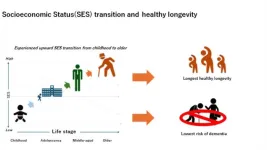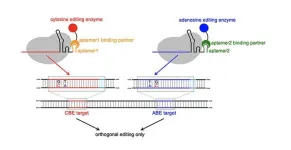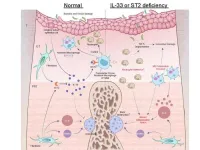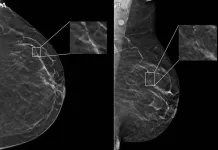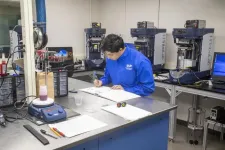(Press-News.org) Birmingham researchers have shown PEPITEM, a naturally occurring peptide (small protein) holds promise as a new therapeutic for osteoporosis and other disorders that feature bone loss, with distinct advantages over existing drugs.
PEPITEM (Peptide Inhibitor of Trans-Endothelial Migration) was first identified in 2015 by University of Birmingham researchers.
The latest research, published today in Cell Reports Medicine, show for the first time that PEPITEM could be used as a novel and early clinical intervention to reverse the impact of age-related musculoskeletal diseases, with data demonstrating that PEPITEM enhances bone mineralisation, formation and strength, and reverses bone loss in animal models of disease.
The research was funded by major grants from the Medical Research Council and the Lorna and Yuti Chernajovsky Biomedical Research Foundation, which funds pioneering research into the creation of new targeted medicines to improve health. Other funders included the British Society for Research on Ageing, and Versus Arthritis.
Bone is constantly formed, reformed, and remodelled throughout life, and up to 10% of human bone is replaced annually through a complex interplay between two cell types – osteoblasts, which form bone, and osteoclasts, which breakdown bone. Disturbances to this tightly orchestrated process are responsible for features of diseases such as osteoporosis and rheumatoid arthritis, which show excessive bone breakdown, or ankylosing spondylitis, where abnormal bone growth occurs.
The most commonly used osteoporosis therapies (bisphosphonates) target osteoclasts to prevent further bone loss. Although there are new ‘anabolic’ agents that can promote new bone formation, these have limitations in their clinical use, with teriparatide (parathyroid hormone, or PTH) only being effective for 24 months and romosozumab (anti-sclerostin antibody) being associated with cardiovascular events.
Therefore, there is a clear case for developing new therapies to stimulate bone repair in age-related musculoskeletal diseases, of which osteoporosis is the most common. Researchers led by Dr Helen McGettrick and Dr Amy Naylor, including Dr Jonathan Lewis and Ms Kathryn Frost, from the Institute of Inflammation and Ageing at the University of Birmingham and Dr James Edwards from Nuffield Department of Orthopaedics, Rheumatology and Musculoskeletal Sciences at the University of Oxford set out to investigate the potential therapeutic impact of PEPITEM in these disease states.
PEPITEM is a naturally occurring short protein (peptide) produced in the body and found circulating in everyone at low levels.
The research findings demonstrated that PEPITEM regulates bone remodelling and that increasing the amount present in the body stimulates bone mineralisation in ‘young bones’ that are not in a diseased or pre-osteoporotic state, and that this translates to an increase in bone strength and density similar to current standard of care drugs (bisphosphonates and PTH).
However, the key test for a potential new therapeutic is its ability to target the natural repair process that is compromised by age, or inflammatory disease. Here the researchers showed that giving additional PEPITEM limits bone loss and improves bone density in animal models of the menopause, which is a common trigger for osteoporotic bone loss in humans. Their studies also showed similar findings in models of inflammatory bone disease (arthritis), where PEPITEM significantly reduced bone damage and erosion.
These findings were underscored by studies using human bone tissue, harvested from older patients during joint surgery. These studies showed cells from older individuals respond to PEPITEM, significantly increasing the maturation of osteoblasts, and their ability to produce and mineralise bone tissues.
Their cell and tissue culture work showed PEPITEM has a direct effect on osteoblasts to promote bone formation, by increasing the activity of osteoblasts rather than their number. Further studies identified the NCAM-1 receptor as the specific receptor for PEPITEM on osteoblasts, and strongly suggested the NCAM-1- b-catenin signalling pathway is responsible for the upregulation of osteoblast activity. This receptor, and the pathway, are distinct from PEPITEM receptors that have been previously described in other tissues.
The researchers also investigated PEPITEM’s effect on osteoclasts and bone resorption. Here, mouse studies showed PEPITEM significantly reduces the number of osteoclasts, leading to reduced bone mineral resorption. The researchers subsequently demonstrated that the reduction in osteoclast activity is the result of a soluble substance released locally in bone tissues by osteoblasts ‘activated’ by PEPITEM.
Dr Helen McGettrick said: “While the most commonly used drugs, bisphosphonates, work by blocking the action of osteoclasts, PEPITEM acts by swinging the balance in favour of bone formation, without impacting the ability of osteoclasts to resorb regions of damaged or weak bone tissue via normal bone remodelling.”
Helen Dunster, the Business Development Manager who has curated the intellectual property associated with PEPITEM for the last 8 years says: “PEPITEM is the subject of a number of patent families relating to its activity in inflammation and inflammatory immune-mediated, bone and obesity related diseases, and also comprising of smaller PEPITEM pharmacophores. A US patent application (US18488234) covering the use of PEPITEM in the treatment or prevention of bone disease, has a priority filing date of 8/10/2019.”
END
New therapeutic avenues in bone repair
2024-05-21
ELSE PRESS RELEASES FROM THIS DATE:
Socioeconomic status transition throughout life and risk of dementia
2024-05-21
About The Study: This cohort study of Japanese older adults identified that upward and downward socioeconomic status transitions were associated with risk of dementia and the length of dementia-free periods over the lifespan. The results may be useful to understand the association between social mobility and healthy longevity.
Corresponding Author: To contact the corresponding author, Hiroyasu Iso, Ph.D., email iso@pbhel.med.osaka-u.ac.jp.
To access the embargoed study: Visit our For The Media website at this link https://media.jamanetwork.com/
(doi:10.1001/jamanetworkopen.2024.12303)
Editor’s Note: Please see ...
Climbing the social ladder slows dementia, Japanese study reveals
2024-05-21
Osaka, Japan – Upward social mobility may ward off dementia, according to a new study. Dementia, a collective term for conditions marked by memory loss and diminished cognitive functioning, strains healthcare systems and devastates quality of life for patients and their families. Research thus far has found correlations between socioeconomic status (SES) – Parent’s asset, education level, income, and work status – and susceptibility to dementia, and SES changes throughout a person’s life, known as social mobility, seem to influence this risk; however, scientific ...
Researchers discover hidden step in dinosaur feather evolution
2024-05-21
Scientists discover ‘zoned development’ in dinosaur skin, with zones of reptile-style scales and zones of bird-like skin with feathers
New dinosaur skin fossil found to be composed of silica – the same as glass
Discovery sheds light on evolution from scales to feathers
Palaeontologists at University College Cork (UCC) in Ireland have discovered that some feathered dinosaurs had scaly skin like reptiles today, thus shedding new light on the evolutionary transition from scales to feathers.
The researchers studied a new specimen of the feathered dinosaur Psittacosaurus from the early Cretaceous ...
Studies reveal cell-by-cell changes caused when pig hearts and kidneys are transplanted into humans
2024-05-21
Surgical teams at NYU Langone Health performed the world’s first genetically modified pig kidney transplants into a human body in September and November 2021, and then transplanted two pig hearts in the summer of 2022. These procedures were done in patients declared dead based on neurologic criteria (decedents) and maintained on ventilators with the consent of their families. Demonstrating the field’s progress, NYU Langone in April 2024 transplanted a pig kidney into a living patient.
Now two new analyses, one published online on May 17 in Nature Medicine and the other May ...
SRI earns FDA Orphan Drug Designation for pancreatic cancer
2024-05-21
SRI’s Targeted Antigen Loaded Liposomes (TALL) — a treatment that expands the benefits of immunotherapy such as check-point inhibitors — has been granted Orphan Drug Designation (ODD) for pancreatic ductal adenocarcinoma (PDAC) by the U.S. Federal Drug Administration (FDA).
As a result, SRI’s future strategic partners can gain tax credits for qualified clinical trials and potentially receive market exclusivity for a period of seven years after the drug’s approval, among other benefits.
“FDA's orphan drug designation brings worthy attention to the demonstrated impact of SRI's TALL biotherapeutic for pancreatic cancer,” said Kathlynn Brown, ...
A new gene-editing system tackles complex diseases
2024-05-21
The human genome consists of around 3 billion base pairs and humans are all 99.6% identical in their genetic makeup. That small 0.4% accounts for any difference between one person and another. Specific combinations of mutations in those base pairs hold important clues about the causes of complex health issues, including heart disease and neurodegenerative diseases like schizophrenia.
Current methods to model or correct mutations in live cells are inefficient, especially when multiplexing — installing multiple point mutations simultaneously across the genome. Researchers from the University of California San Diego ...
Tracking down toxic metals from tobacco smoke
2024-05-21
Cigarette smoke has been studied for years, revealing a multitude of contaminants, including toxic metals. But exactly which of those metals can be traced to secondhand or thirdhand smoke? Solving this problem has been a challenge for the research community because many of the metals found in tobacco smoke could also come from industrial or naturally occurring pollutants contaminating indoor and outdoor air.
Now, a recent study by scientists at Lawrence Berkeley National Laboratory (Berkeley Lab) has identified 28 trace metals in tobacco smoke. The findings reported in the journal ...
Clarifying the cellular mechanisms underlying periodontitis with an improved animal model
2024-05-21
TMDU researchers have developed a technique that allows a detailed analysis of periodontitis development over time
Tokyo, Japan – Periodontal disease, represented by periodontitis, is the leading cause of tooth loss and affects close to one in five adults worldwide. In most cases, this condition occurs as a result of an inflammatory response to bacterial infection of the tissue around teeth. As the condition worsens, the gums begin to pull away, exposing teeth roots and bone. Notably, the incidence of periodontitis becomes more prevalent with age and with populations worldwide living ...
Age, race impact AI performance on digital mammograms
2024-05-21
OAK BROOK, Ill. – In a study of nearly 5,000 screening mammograms interpreted by an FDA-approved AI algorithm, patient characteristics such as race and age influenced false positive results. The study’s results were published today in Radiology, a journal of the Radiological Society of North America (RSNA).
“AI has become a resource for radiologists to improve their efficiency and accuracy in reading screening mammograms while mitigating reader burnout,” said Derek L. Nguyen, M.D., assistant professor at Duke University in Durham, North Carolina. ...
SwRI leads courses at 2024 Society of Tribologists & Lubrication Engineers Annual Meeting
2024-05-21
SAN ANTONIO — May 21, 2024 —As a leader in fuels and lubricants research, Southwest Research Institute is home to a world-class tribology laboratory and expert staff that are developing advanced techniques and technology to study wear, friction and lubrication. SwRI tribologists will share their expertise at the 2024 Society of Tribologists and Lubrication Engineers (STLE) Annual Meeting May 19-23 in Minneapolis.
The STLE Annual Meeting and Exhibition invites members of the lubricant industry ...
